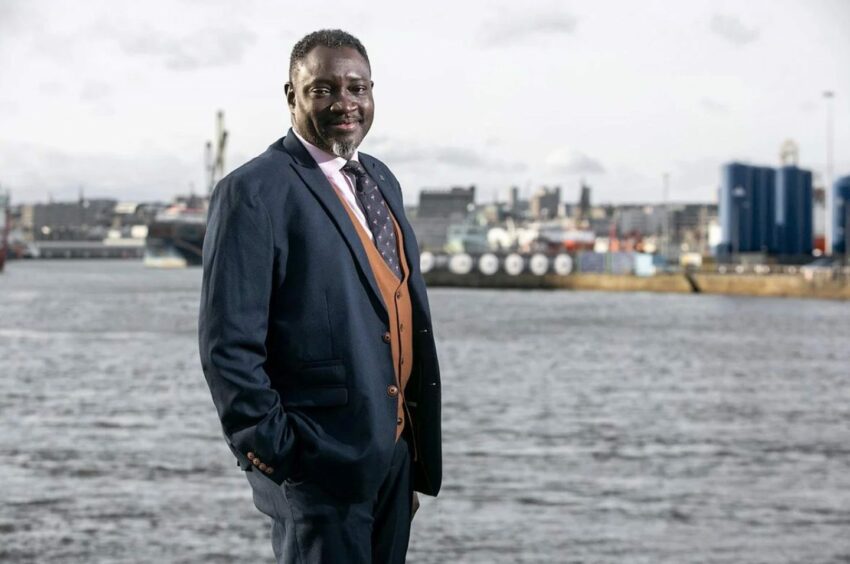 © Supplied by -
© Supplied by - Progress is being made on D&I in the oil and gas sector, says AFBE-UK’s Ollie Folayan, but there’s still much more work to do.
Nearly two years ago, trade body OEUK put out its first Diversity, Equality and Inclusion (DE&I) index, setting the scene for the North Sea industry.
It’s an issue the historically white, male-dominated industry is switching on to, and Dr Ollie Folayan, chair of AFBE-UK Scotland (Association for Black and Minority Ethnic Engineers), is confident about the direction of travel, even in that short intervening period.
Among the 2021 results, however, were groups including Black, LGBTQ+ and disabled workers scoring the industry well below the average on its diversity and inclusion progress.
The next edition of the survey is now underway so, two years on, can we expect to see improvement?
“There has been quite a lot of work done, and I hope some of that translates down into positive experiences,” says Folayan, referencing work from companies, as well as his own team and others like gender equality group Axis Network.
“That said, I still have conversations with people all the time…these are often people who, from a distance, you would see as doing very well in their careers, who are still having not the best of times.
“It’s often been quite disappointing, sometimes, we see people who are on the face of it doing very well but there are still these issues they are having to address, often around unfair treatment, exclusions from certain kinds of opportunities and still too many, dare I say it, NDAs being signed after irreconcilable situations.
“But what I certainly see is there has been a little more openness and therefore a little bit more accountability, and what I hope the new survey reflects is some of that translating into positive perceptions as well.”
Even looking back to 2020, Folayan notes major progress in terms of the types of conversations being had.
“At leadership level, there used to be a time when certain conversations were just off the table, you would not find them.
“These days I very rarely find a senior leader who is not comfortable talking about issues surrounding DE&I because they recognise the importance.
“I don’t believe for a moment that is performative, I believe it is genuine and deeply felt, especially at senior level.”
Middle management – the impermeable layer – is where there can still be some communication issues on that front.
It’s a huge cultural change for this industry, can we expect change so soon? Should we be checking in so regularly?
In a word, yes.
“It indicates how seriously we see this issue and how important we think it is for our development as a sector.
“The obvious parallel is safety. EV’s article a few months ago on the HSE front, I remember sharing that, we’ve let a lot of things slip a little bit on HSE checks and inspections and so on and I think, if we do the same with this, we end up being exactly where we are.
“So I think it’s fair question to ask, how are we doing and thinking of ways to measure progress.”
Performative versus actual change
There’s an important difference between “performative” actions and genuine change, and there is a risk of pitfalls.
It is recognised that good D&I practices mean improved business performance, and it is now playing into ESG considerations for financial institutions making lending decisions to oil firms, as one Harbour Energy VP noted last year at an industry conference.
That is a good idea, says Folayan, who notes that companies are looking at their teams, as well as the work of their supply chains.
But with greater awareness of these issues, there needs to be greater scrutiny.
“I think we need to be careful because there is a difference between companies who present things well and who are actually doing things well.
“It is very possible to learn an DE&I lexicon and for things to appear good.
“It’s the same issue that gets addressed when we talk about social value embedded in contracts; it risks performative situations.
“I remember being the judge of an DE&I awards some years ago and when the finalists were announced, we were getting phone calls from people saying ‘are you (expletive) kidding me?’
“It just so happened this company was very good at putting themselves in a positive light in an application, but they weren’t actually doing the work and that was reflected in the terrible experiences that a lot of people of colour had in their company.”
Overall, Folayan is seeing positive early signs for the industry, and the dial is shifting more widely on understanding of these issues.
A year ago, he noted that D&I was broadly seen as mainly just a question of gender but now a wider “intersectionality” of the various issues it represents are coming to the fore.
Meanwhile AFBE-UK Scotland is seeing further recognition for its own works – it has risen from around 60 partnerships last year to around 90 today.
For those firms not taking note of the DE&I landscape, Folayan warns that the workforce has agency and will go to work environments where they feel fulfilled – those not providing that will be left behind.
“I’m seeing a change there, but these are first steps in the direction we need to continue to go down.
“I think the other intersection people are talking about now are issues around social class, which don’t get spoken about enough in these contexts.
“For most people, the biggest barrier to any kind of opportunity will still be the circumstances they were brought up in. I think the deepening of that understanding has been very important.
“Early signs continue to be positive but we just need to keep moving in that direction, stay consistent and stay cohesive.”
